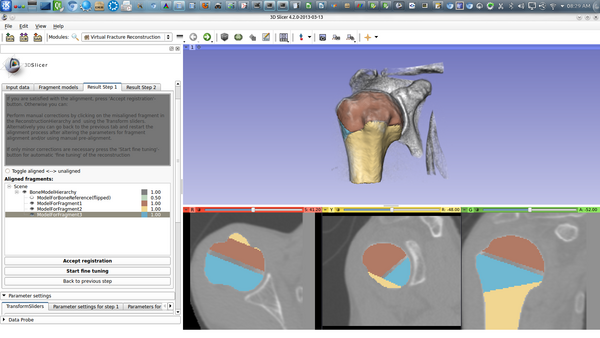2013 Summer Project Week: Computer Assisted Surgery
Key Investigators
- MGH/BWH/UMIT: Karl Fritscher
- GATECH: Peter Karasev
- BWH: Ron Kikinis, Steve Pieper
Objective
The repositioning of fracture fragments during a surgical intervention often requires a trial and error approach, which leads to a significant prolongation of the surgery and causes additional trauma to the fragments and the surrounding soft tissue. Wound healing failure, infections, or joint stiffness can be the consequence. Therefore, there is a clear trend towards the development of less invasive techniques to reconstruct complex fractures. In order to support this trend, software tools for calculating and visualizing the optimal way of repositioning fracture fragments based on the usage of segmented CT images as input data have been developed. In several studies, they have successfully demonstrated their potential to decrease operation times and increase reduction accuracy. However, existing software tools are often restricted to particular types of fractures and require a large amount of user interaction. Hence, the main objective of the project is to overcome these limitations by developing an algorithmic pipeline that is calculating and visualizing the optimal way of repositioning fracture fragments with a minimal amount of user interaction and without restrictions to particular types of fractures.
Plan
Novel concepts like the usage of prior knowledge about the shape of the healthy (=non-fractured) bone during the reconstruction process will be applied. Moreover, information coming from CT volumes will be combined with information on geometric surface properties in order to identify corresponding (fragment) surface points.
Progress
- A slicer command line module + loadable module has been created.
- An extension has been for the modules.
- The two modules have been uploaded as an extension.
- CDash output: 0 warnings, 0 errors (testen on Linux and Windows 64bit)
- WIKI page for extension available here: https://www.slicer.org/wiki/Documentation/Nightly/Extensions/VirtualFractureReconstruction


